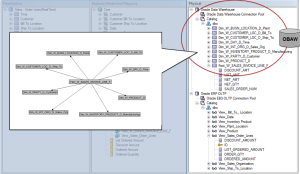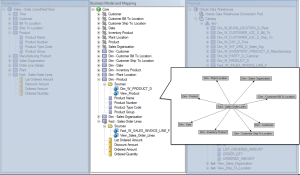Fulfilling Real-Time analytics on Oracle BI Applications platform
Analytics users have always had the desire to get “real-time” data. There are certain business scenarios where the ability to do real-time analysis can positively impact different areas of our Business – from increased revenue to a greater customer satisfaction.
Most of the Oracle BI Application deployments my team and I have been a part of, have always had some Real-Time components.There are a number of design approaches to extend the Oracle BI applications foundation in order to fulfill these requirements. In this article, I would like to share one of the design approaches I will be presenting with my colleague during Oracle OpenWorld 2014. If you are visiting the Oracle Open World this year, please join us to discuss this topic and any other questions on Oracle Business Intelligence:
Session ID: CON6485
Session Title: Leverage Oracle BI Applications Architecture to Meet Real-Time Reporting Requirements
Venue / Room: Moscone West – 3011
Date and Time: 10/1/14, 16:30 – 17:15
Click here to download the slide deck
What is “Real-Time Analytics”?
Real-time business intelligence (RTBI) is the process of delivering information about business operations as they occur. Real time means near to zero latency and access to information whenever it is required. – Wikipedia
Some of the common business scenarios for real-time analytics we always run into are:
- Access to Point Of Sale transactions to efficiently manage Inventory and Store Cash
- Operational reports for Business that depend on timely deliveries
- Users simply need critical operational data in real-time
Let’s take a look at the design approach to fulfill real-time analytics on Oracle BI applications Platform
For those of you who are not familiar with Oracle BI Applications, It is a pre-packaged and prebuilt BI tool that enables organizations to realize the value of a packaged BI Application, such as rapid deployment, lower TCO, and built-in best practices, while also being able to very easily extend those solutions to meet their specific needs, or build completely custom BI applications, all on one common BI architecture.
Business Requirement: Show me the list of Order Quantity by Customer and Product in real Time.
In order to fulfill this requirement, we will extend the OBIEE metadata to seamlessly integrate data from two data sources:
- Oracle Business Analytics Warehouse (OBAW) for historical data (This would be the data loaded as of the night before)
- Transactional Data (OLTP).
Figure- 1
The Physical layer is an exact depiction of the target physical database(s). Figure 2 shows an Out of the Box (OOTB) Sales Invoice Line Fact and its relationship with OOTB Dimensions.
Figure- 2
Similarly, in order to access the real-time data, we created views in our transactional system that would store transactions occurred since the nightly load. Now, based on the real-time reporting requirement, we may need to create multiple views depending on the number of dimensions we want our users to be able to seamlessly analyze and slice real-time data. As you can see in figure 3, we created seven dimensional views in order to provide the ability to slice real-time data by those dimensions.
Figure- 3
The Business Model is a layer of abstraction that sits on top of the physical data. The Business Model allows us to collapse multiple dimension tables or multiple fact tables coming from disparate physical sources into a single logical table. As you can see in Figure-4, there is one Logical Fact and One Logical Dimension for two disparate sources (OBAW and OLTP).
The Business Model also contains some of the rules for how the databases should be interrogated. If the application contains Aggregate or Partitioned database tables used to improve query response times, these rules would be defined within the Logical Table Sources within the Business Model. We will leverage this functionality to federate data from two Physical data sources.
Figure- 4
We need to map the Physical column for each Logical Table sources. As you can see in Figure-5, Ordered Amount is mapped to NET_AMT for W_SALES_INVOICE_LINE_F (OBAW Fact Table) and ORDERED_AMOUNT for View_Sales_Order_lines_Fact (OLTP Table).
Figure- 5
Similarly, we need to map the Physical column for each Dimensions, Logical Table sources.
Figure- 6
The Presentation layer is a second layer of abstraction that sit-on-top of Business Model. The Presentation layer is presented to end-users in a complete WYSIWYG framework.
Figure- 7
Per the design steps completed above, when we try to create a report. OBI generates queries for each data source. Data returns from each data source. Data is then integrated on the OBI Server before displaying it to the users.
Figure- 8
Below is a 3-Tier architecture diagram to fulfill real-time and analytical reporting need without adversely impacting the ERP (Business) Applications.
Figure- 9
ABOUT THE AUTHOR:
Shiv Bharti is the Practice Director of Perficient’s (NASDAQ:PRFT) National Oracle Business Intelligence Practice. Shiv has solid experience building and deploying Oracle Business Intelligence products. He has successfully led the implementation of more than 75 Business Analytics and custom data warehouse projects.
Shiv is a thought leader in the Business Analytics space and a frequent speaker at large conferences like – Oracle Open World, Collaborate, KScope as well as Oracle User Group, sharing his perspectives and thoughts on industry trends,strategies, best practices and case studies.











Nice article.any recording of the session expected?
Like the meticulously explained diagrams!!
Great Article about Oracle Application